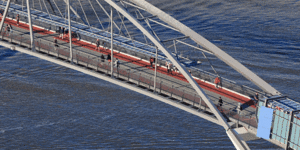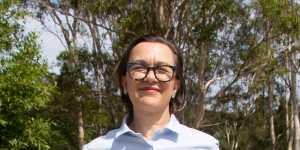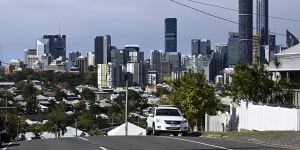According to a leading liveability report,that very much depends on how close one gets to the CBD – walkability in Brisbane is far from a level playing field.
The Australian Urban Observatory’s study into Brisbane’s walkability,which measures the ease of walking in individual suburbs,shows a clear divide between inner-city life and that of people living in the city’s outer suburbs,many of which were planned.
The data shows that,when it comes to walkability,Brisbane may as well be a tale of two cities.

It’s easier to get around on foot in Brisbane’s inner suburbs,a report says.Adobe
“Neighbourhoods with shops and services to walk to,small blocks and good street connectivity,and higher population density tend to be more walkable,” the RMIT Centre of Urban Research-based AUO notes in its2021 Liveability Report for Brisbane,which will be released this week.
(The lag between the report’s time period and its publication date was due to AUO needing to wait until all data sets from 2021 were released.)
“Walkable neighbourhoods discourage driving and increase walking,cycling and active transport use,which improves levels of physical activity and reduces chronic disease outcomes.”

The top scores in Brisbane are concentrated in the five-kilometre ring around the CBD,with the only outliers being Annerley,Fairfield,Taringa,Lutwyche,Wooloowin,Clayfield and Chermside.
Outside the Brisbane City Council limits,Redcliffe and Beenleigh were the only suburbs to receive a score of nine.
Ultimately,those residents who could incorporate walking more into their lives would reap the health benefits,including reduced risk of heart attack and stroke,improved mental health and vitamin D absorption from getting a little sun.
Greg Mews,urban planning lecturer at the University of the Sunshine Coast,said the inequality of infrastructure,favouring the more affluent inner city,was not unique to Brisbane.
A person’s postcode,Mews said,was the biggest single measure for their quality of life. That made any discussion about a city’s overall quality of life somewhat moot because there was always so much nuance,diversity and inequality within its city limits.
Mews said the attractiveness – or otherwise – of walking was very much determined by the built environment in which would-be pedestrians found themselves.

And not all built environments were created equal.
“The built environment can play a role,particularly as it caters to our unconscious choices,” Mews said.
“For example,if you design an environment for walking and make walking the easiest,most convenient choice – and we are social beasts,who like convenience – then you automatically leverage the built environment design and you actually increase the amount of people who walk.
“I mean,that’s not rocket science.
“But if you design,as we’ve done in Australia for so many years,a very car-centred approach and make that the most convenient way to get around,of course you’re not going to get the most physically active people on average.”
Queensland Walks executive officer Anna Campbell said the AUO data did not tell the whole story.
While the report’s macro view of Brisbane looked primarily at walking distances,Campbell said,a closer look showed things were far from rosy,even in the inner city.
“TheLiveability Report for Brisbane conducted by the AUO measured three main things:destinations,density and distance. However,walkability is more complex,” she said.
“Walkability should also be measured by the conditions of our footpaths. In Brisbane’s CBD,as an example,footpath conditions are horrendous right now.
“In my time living in Brisbane,I’ve never seen Brisbane footpaths in a worse condition.
“Partly,that’s because of developmental impacts and temporary closures,but equally it’s because our footpaths haven’t been well maintained – we just haven’t been budgeting appropriately for it. ”

Queensland Walks executive officer Anna Campbell says she has never seen Brisbane footpaths in a worse condition.Supplied
And Campbell said the situation was worse in the suburbs,where the condition of footpaths made it hard to get around,especially for people in wheelchairs – and that was before considering a lack of footpaths in about 6000 streets across Brisbane.
“We should be providing high-quality places and encouraging people to walk and ride with full pedestrianisation to reduce car use in those shorter local trips,” she said.
“At the moment,we’re encouraging more car use rather than walking up to local community hubs or walking to school,or work or the train.”
Campbell said design features such as raised crossings,which resembled speed bumps and did away with the need for kerb ramps to go down then back up again – a good example was King Street in Fortitude Valley – and increased vegetation cover for shade were vital to make walking a more attractive option for pedestrians.
That would mean healthier people,Campbell said,and it could also help reduce neighbourhood crime.
“The more people you’re seeing out on the street and more people engaging,you’re going to have much safer connected communities,” she said.
Suburban Futures co-founder Ross Elliott,the chairman of the Lord Mayor’s Better Suburbs Initiative,said more needed to be considered than distance. Brisbane’s topography presented its own challenges.
“It’s not just proximity – Brisbane is a hilly city,so you can be close to your destination,but walking,or cycling,doesn’t work,” he said.
“This is not Copenhagen. We’re not flat as a plank and cold. I’m sure you can ride around Copenhagen for hours in a great coat and not feel hot,but you’ve only got to do a couple of hundred metres in Brisbane up a hill and you’re buggered.”

Brisbane’s hilly topography can make walking a challenge.Dan Peled
Elliott said Brisbane’s topography also presented opportunities for pedestrian and cycling infrastructure.
“What you’re already seeing the council doing is exploring active transport along creek corridors. Now,the thing with creek corridors is they might meander because of the creek,but they’re flat and they’re quite pleasant,” he said.
“The space is already public domain anyway,so if you can achieve an environmental outcome,an active transport outcome and a stormwater mitigation outcome by clearing up some of our creeks and waterways,then that’s terrific.”
The 2032 Brisbane Olympic Games would be a great opportunity to right some wrongs,Mews said.
“If you want to address and to create good transport – and transport,to me,is not just buses and rapid transit,but everything from the footpath onwards – that can be extra incredibly exciting,if they’re tackling it with the right priority,” he said.
“... When they come to retrofit for the Olympics,they’re not going to target the newly developed areas,but they’re looking into the existing fabric – and getting that balance right is a complex issue;it’s nuanced.
“Because we’re working with existing fabrics,you work with existing communities,and you need to sell them that they actually benefit from the Olympics as part of their everyday life. How does it make their lives more convenient,essentially.”
Campbell said pedestrian infrastructure needed to be a priority going into 2032 and beyond.
“If you review how much is being spent on walking in Brisbane,in comparison to what we’re spending on road infrastructure,it’s disproportionate – often it’s less than 1 per cent of the transport budgets,” she said,adding it needed to be closer to 20 per cent.
“Every time there’s a[transport] budget cut,it comes straight out of walking and cycling projects and that’s exactly the opposite of what we should be doing – for now and with population increase,but also for the Paralympic and Olympic Games,preparing for more people,more tourists in our city,and[in our] suburbs.
“It’s about design and investment,essentially,and then maintaining what we already have so it doesn’t worsen.”
This article was produced in collaboration with the Australian Science Media Centre,with support from the Walkley Foundation-administered Meta Public Interest Journalism Fund.